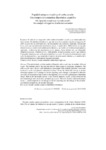Español antiguo recudir y el verbo acudir. Un ejemplo de semántica diacrónica cognitiva

Ver/
Use este enlace para citar
http://hdl.handle.net/2183/27928
A non ser que se indique outra cousa, a licenza do ítem descríbese como Atribución-NoComercial-CompartirIgual 4.0 Internacional (CC BY-NC-SA 4.0)
Coleccións
Metadatos
Mostrar o rexistro completo do ítemTítulo
Español antiguo recudir y el verbo acudir. Un ejemplo de semántica diacrónica cognitivaTítulo(s) alternativo(s)
Old Spanish Recudir and the Verb Acudir. An Example of Cognitive Diachronic SemanticsAutor(es)
Data
2021-01-30Cita bibliográfica
Santano Moreno, J. (2021). Español antiguo recudir y el verbo acudir. Un ejemplo de semántica diacrónica cognitiva. Revista de Lexicografía, 26, 131-158. https://doi.org/10.17979/rlex.2020.26.0.7100
Resumo
[Resumen] El artículo se ocupa del verbo medieval español recudir y su continuador moderno acudir. El método utilizado es el que deriva de la semántica diacrónica cognitiva. El verbo recudir era un verbo deíctico y de movimiento con dirección implicada, movimiento hacia atrás con una dimensión prospectiva detrás. A partir del s. XIII aparece un segundo prototipo con un cambio en la señalización deíctica y un cambio en la dirección prospectiva implicada: la dirección del movimiento es la opuesta, hacia delante con una dimensión prospectiva delante. También el s. XIII aparece un nuevo lexema, acudir, que continúa el segundo prototipo y que acaba por reemplazar recudir. El nuevo lexema presenta como sufijo la preposición a-, que responde al cambio de señalización deíctica y al cambio de la dirección prospectiva implicada del segundo prototipo. [Abstract] The article deals with the medieval Spanish verb recudir and its modern follower acudir. The method used is the one that derives from cognitive diachronic semantics. The verb recudir was a deictic verb indicating a movement with implied direction, movement backwards with a prospective dimension behind. From the thirteenth century a second prototype appears with a change in deictic signaling and a change in prospective direction involved: the direction of movement is the opposite, forward with a prospective dimension ahead. Also in the thirteenth century a new lexeme appears, acudir, which continues the second prototype and which ends up replacing recudir. The new lexeme suffixes the preposition a-, which responds to the change in deictic signaling and the change in the prospective direction implied by the second prototype.
Palabras chave
Recudir
Acudir
Semántica diacrónica cognitiva
Cognitive diachronic semantics
Acudir
Semántica diacrónica cognitiva
Cognitive diachronic semantics
Versión do editor
Dereitos
Atribución-NoComercial-CompartirIgual 4.0 Internacional (CC BY-NC-SA 4.0)
ISSN
2603-6673
1134-4539
1134-4539






